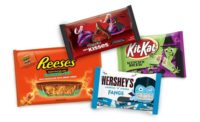Gum, mints, hard sugar candy, gift box chocolates, and breath fresheners have all seen a decrease in dollar sales over the last year.
However, other categories have seen an increase in dollar sales, including: chocolate candy, non-chocolate candy, and sugar-free chocolate candy.
That’s according to data from IRI, a Chicago-based market research firm (@iriworldwide). The figures are based on the latest 52 weeks ending Oct. 4, 2020.
The numbers offer a glimpse into how the COVID-19 pandemic may be impacting the confectionery industry. While the “why” behind some of the changes requires analysis, the raw data makes it clear that the coronavirus has indeed left its mark on the sector.
Gum, breath freshener dollar sales see significant decreases
The gum and breath freshener categories have taken the biggest hits in the sector.
Gum sales are down 15.5 percent, to $2.6 billion. Within the category, regular gum sales are down 13.9 percent to $396 million and sugarless gum sales are down 15.8 percent to $2.3 billion.
And drilling down a little further, within the regular gum, non-sugarless category, the top selling product, Wrigley's Doublemint Gum saw an 18.6 percent decrease in sales to $83.3 million. The second most selling product was Wrigley's Juicy Fruit, which saw sales decrease 12.2 percent to $54 million.
When it comes to sugar-free gum, Wrigley's Extra gum saw sales fall 8.7 percent to $493 million. And the second most selling brand, Ice Breakers Ice Cubes saw sales decrease 6.5 percent to $303 million.
Overall breath freshener sales were down 20.4 percent to $625.1 million. Within that category, IRI breaks the data down into two subcategories, "breath fresher" and "breath freshener sprays/drops." In the "breath freshener" subcategory, sales were down 20.4 percent to $608.5 million. While in "breath freshener sprays/drops" subcategory, sales were down 19.8 percent to $16.6 million.
The top selling breath freshener company, The Hershey Company, saw a 20.6 percent decrease in sales to $256.3 million.
The top selling breath freshener sprays/drops company, Johnson & Johnson, saw a 20.7 percent decrease in sales to $11 million. It's only product in the category is Listerine Pocketmist, which the same decrease in sales. However, despite that, it was the top selling product in the category.
Earlier this year Hershey CEO Michele Buck said consumers usually reach for gum and mints for functional reasons, rather than emotional reasons.
However, with COVID-19 impacting so much of consumers’ daily life, and drastically reducing in-person interactions, there’s less of a functional reason to reach for products that freshen your breath. Many are Americans also are working from home, which means they no longer have a commute that may have included regular stops and purchases like gum. In addition, most people are wearing masks now, which also may impact how often consumers reach for products like gum.
Hard sugar candy dollar sales decrease
Another category that saw a notable decrease in sales was hard sugar candy/package and roll candy. Sales were down 5.5 percent to $555.1 million.
The top selling product, Jolly Ranchers, saw sales decrease 1.9 percent to $123.1 million.
However, the second most selling product, Storck Werther's Original actually saw a 6.5 increase in sales to $99.4 million.
The third most selling product, Charms Blow Pops, did see a decrease of 8.8 percent to $42.7 million. And the fourth most selling product, Lifesavers, saw a 10.8 percent decrease in sales to $41.7 million.
Rounding out the Top 5 was Private Label, which saw an 11.2 percent decrease in sales to $33.7 million.
This is another category that likely is impacted by the massive shift to work-from-home for many Americans, as well as a huge spike in virtual learning for many schools. Without regular commutes to work and school, there’s less opportunity to reach for these types of products at the checkout.
Social distancing may have impacted gift box chocolates
COVID-19 also has decreased parties and family gatherings, which may explain why gift box chocolate sales are down 7.6 percent to $208.2 million.
However, not all individual brands saw a drop. The top selling product, Ferrero Rocher saw an increase of 7.8 percent to $72.1 million.
A big portion of the overall gift box sales category drop was likely due to a 33 percent decrease in Russell Stover gift box chocolate dollar sales, which fell to $58.1 million. The product was the second most selling item in the category.
The third most selling product, Ferrero Collection, saw an 8.5 percent increase in sales, to $40.1 million.
And while the fourth selling product Queen Anne gift box chocolates, did see a 4.7 percent increase in dollar sales to $34.8 million, the product's unit sales were actually down 6.7 percent to 17.9 million. And the company increased the unit price 21 cents to $1.94.
Rounding out the top five products was Lindt, which saw an 8.3 percent increase in sales to $12.1 million.
Snack size sales may point to successful Halloween
While the IRI data that Candy Industry receives does not specify seasonal candy sales, chocolate candy snack size sales were up 6.3 percent to $1.2 billion.
So overall, that might be good news for Halloween sales, which has been a hot topic this year. It's been hard to predict how many people will feel safe trick-or-treating, and there has been industry concern that a lack of trick-or-treating would negatively impact candy sales.
However, many consumers reach for snack size products when stocking up for trick-or-treating.
And within that category, Hershey, the top selling company, saw an 8.2 percent increase in sales to $659 million. Second was Mars, which saw a small decrease of 0.4 percent in sales to $398 million. The third most selling company was Ferrero USA, which saw an increase in 32 percent to $98.1 million.
The next few months of fall and winter holidays will likely be a good indicator of how the candy industry will fare amidst the COVID-19 pandemic. And it will be interesting to see if any of the impacts will result in permanent changes for the sector.
Below is a look at all the category data:
Gum sales
Gum sales are down 15.5 percent, to $2.6 billion
Within that category:
- Gum sales are down 31.9 percent to $396.5 million
- Sugarless gum sales are down 15.8 percent to $2.26 billion
Chocolate candy
Chocolate candy sales are up 4 percent, to $15 billion
Within that category:
- Chocolate candy box/bag/bar less than 3.5 ounces is up 3.6 percent to $4.6 billion.
- Chocolate candy box/bag/bar over 3.5 ounces is up 7.6 percent to 5.7 billion.
- Chocolate candy snack size sales are up 6.3 percent to $1.2 billion.
- Gift box chocolates are down 7.6 percent to $289.2 million.
- Novelty chocolate candy sales are up 10.3 percent to $179.1 million.
Non-chocolate candy
Non-chocolate candy sales are up 3 percent to $7.89 billion
Within that category:
- Caramel/taffy apples/kits/dips sales are up 5.3 percent to $94.6 million
- Hard sugar candy/package and roll candy sales are down 5.5 percent to $555.1 million
- Licorice sales are up 6 percent to $476.2 million
- Non-chocolate chewy candy sales are up 6.3 percent to $4 billion.
- Novelty candy sales are up 1.8 percent to $831.2 million
- Plain mint sales are down 9.7 percent to $348.01 million
- Specialty nut/coconut candy sales are down 0.5 percent to $349.6 million
- Sugar-free diet candy sales are down 2.5 percent to $90 million
Breath Fresheners
Breath Fresheners sales are down 20.4 percent to $625.1 million
Within that category:
Breath freshener sales are down 20.4 percent to $608.5 million
Breath freshener sprays/drops sales are down 19.8 percent to $16.6 million





